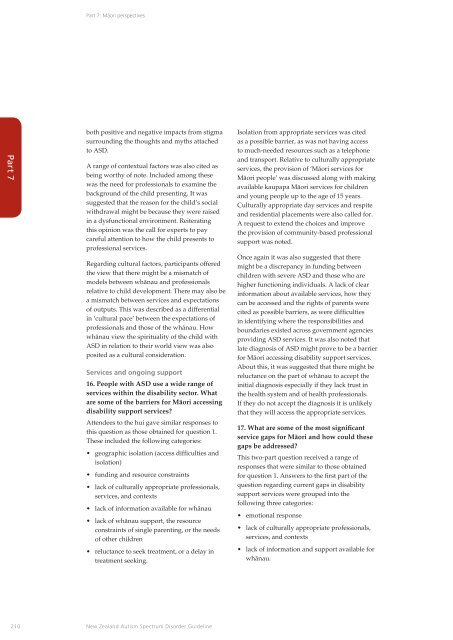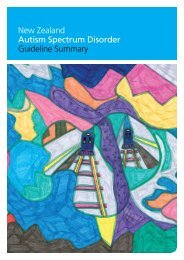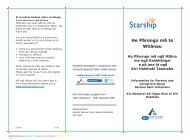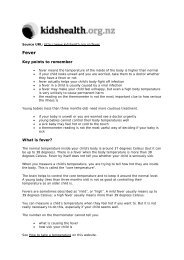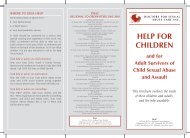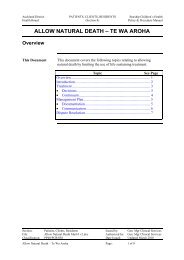New Zealand Autism Spectrum Disorder Guideline - Ministry of Health
New Zealand Autism Spectrum Disorder Guideline - Ministry of Health
New Zealand Autism Spectrum Disorder Guideline - Ministry of Health
You also want an ePaper? Increase the reach of your titles
YUMPU automatically turns print PDFs into web optimized ePapers that Google loves.
Part 7: Mäori perspectives<br />
Part 7<br />
both positive and negative impacts from stigma<br />
surrounding the thoughts and myths attached<br />
to ASD.<br />
A range <strong>of</strong> contextual factors was also cited as<br />
being worthy <strong>of</strong> note. Included among these<br />
was the need for pr<strong>of</strong>essionals to examine the<br />
background <strong>of</strong> the child presenting. It was<br />
suggested that the reason for the child’s social<br />
withdrawal might be because they were raised<br />
in a dysfunctional environment. Reiterating<br />
this opinion was the call for experts to pay<br />
careful attention to how the child presents to<br />
pr<strong>of</strong>essional services.<br />
Regarding cultural factors, participants <strong>of</strong>fered<br />
the view that there might be a mismatch <strong>of</strong><br />
models between whänau and pr<strong>of</strong>essionals<br />
relative to child development. There may also be<br />
a mismatch between services and expectations<br />
<strong>of</strong> outputs. This was described as a differential<br />
in ‘cultural pace’ between the expectations <strong>of</strong><br />
pr<strong>of</strong>essionals and those <strong>of</strong> the whänau. How<br />
whänau view the spirituality <strong>of</strong> the child with<br />
ASD in relation to their world view was also<br />
posited as a cultural consideration.<br />
Services and ongoing support<br />
16. People with ASD use a wide range <strong>of</strong><br />
services within the disability sector. What<br />
are some <strong>of</strong> the barriers for Mäori accessing<br />
disability support services?<br />
Attendees to the hui gave similar responses to<br />
this question as those obtained for question 1.<br />
These included the following categories:<br />
• geographic isolation (access difficulties and<br />
isolation)<br />
• funding and resource constraints<br />
• lack <strong>of</strong> culturally appropriate pr<strong>of</strong>essionals,<br />
services, and contexts<br />
• lack <strong>of</strong> information available for whänau<br />
• lack <strong>of</strong> whänau support, the resource<br />
constraints <strong>of</strong> single parenting, or the needs<br />
<strong>of</strong> other children<br />
• reluctance to seek treatment, or a delay in<br />
treatment seeking.<br />
Isolation from appropriate services was cited<br />
as a possible barrier, as was not having access<br />
to much-needed resources such as a telephone<br />
and transport. Relative to culturally appropriate<br />
services, the provision <strong>of</strong> ‘Mäori services for<br />
Mäori people’ was discussed along with making<br />
available kaupapa Mäori services for children<br />
and young people up to the age <strong>of</strong> 15 years.<br />
Culturally appropriate day services and respite<br />
and residential placements were also called for.<br />
A request to extend the choices and improve<br />
the provision <strong>of</strong> community-based pr<strong>of</strong>essional<br />
support was noted.<br />
Once again it was also suggested that there<br />
might be a discrepancy in funding between<br />
children with severe ASD and those who are<br />
higher functioning individuals. A lack <strong>of</strong> clear<br />
information about available services, how they<br />
can be accessed and the rights <strong>of</strong> parents were<br />
cited as possible barriers, as were difficulties<br />
in identifying where the responsibilities and<br />
boundaries existed across government agencies<br />
providing ASD services. It was also noted that<br />
late diagnosis <strong>of</strong> ASD might prove to be a barrier<br />
for Mäori accessing disability support services.<br />
About this, it was suggested that there might be<br />
reluctance on the part <strong>of</strong> whänau to accept the<br />
initial diagnosis especially if they lack trust in<br />
the health system and <strong>of</strong> health pr<strong>of</strong>essionals.<br />
If they do not accept the diagnosis it is unlikely<br />
that they will access the appropriate services.<br />
17. What are some <strong>of</strong> the most significant<br />
service gaps for Mäori and how could these<br />
gaps be addressed?<br />
This two-part question received a range <strong>of</strong><br />
responses that were similar to those obtained<br />
for question 1. Answers to the first part <strong>of</strong> the<br />
question regarding current gaps in disability<br />
support services were grouped into the<br />
following three categories:<br />
• emotional response<br />
• lack <strong>of</strong> culturally appropriate pr<strong>of</strong>essionals,<br />
services, and contexts<br />
• lack <strong>of</strong> information and support available for<br />
whänau.<br />
210<br />
<strong>New</strong> <strong>Zealand</strong> <strong>Autism</strong> <strong>Spectrum</strong> <strong>Disorder</strong> <strong>Guideline</strong>


